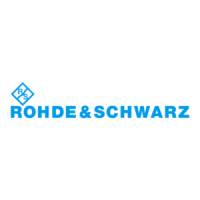M3SR Series 4100 Automatic Link Establishment 3
rd
Generation (ALE-3G)
4.68 Operating Manual 6175.4760.02 – 01
4.4.1.3 ALE-3G Calls
Individual calls (point-to-point), broadcast calls and multicast calls are supported.
R&S EK4100 Systems can only link to broadcast calls, because the acknowledgement
cannot be transmitted.
The operator can initiate synchronous or asynchronous calls in the preselected traffic type
(link mode) to the preselected destination address in one of the following ways:
• Pressing the call button.
• Asserting PTT.
• Presence of data on the data interface.
4.4.1.4 ALE-3G Missions and Database
The operator plans ALE-3G networks using the R&S Mission Planner. The R&S Mission
Planner generates the ALE-3G database for each radio in the network and the operator has
to load the data into each participating radio in the network. The ALE-3G network shall com-
prise 2 radios, but not more than 127 radios.
The ALE-3G database consists of a set of ALE-3G data (initial network parameters) as well
as an entire ALE-2G database. The ALE-3G data is needed to operate the ALE-3G network
and the ALE-2G data is needed for ALE-2G concurrent operation. Each ALE-3G network is
configured to transmit data encrypted (with COMSEC) or plain, which results in different op-
erating modes for ALE-3G.
4.4.1.5 ALE-2G Concurrent Operation in ALE-3G
A radio operating in ALE-3G mode is able to process ALE-2G incoming calls as well. This is
possible due to the fact that ALE-3G addresses and ALE-2G call signs are correlated. The
correlation is handled in the ALE database.
A radio operating in ALE-3G mode is also able to call radios operating in ALE-2G mode.
Due to these features it is possible to have ALE-3G networks with ALE-2G operating radios
integrated.

